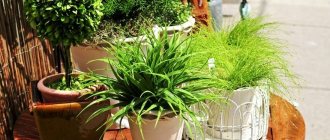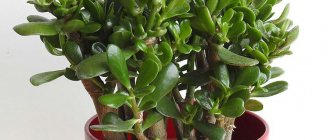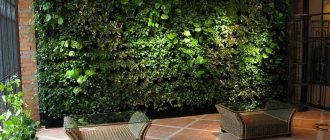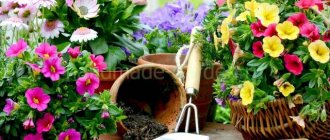Indoor flowers as part of the interior
When designing a living space, it is worth noting that the design should not only please the eye, but also provide comfort. The arrangement of flowers in the interior of the apartment should be organized so that the room is not cluttered, but its advantages are emphasized. An interior with flowers in an apartment looks more comfortable and has undeniable advantages:
- an abundance of greenery relieves eye fatigue and helps you relax after a hard day at work;
- fresh flowers regulate humidity and purify the air;
- plants can optically change the proportions of a room.
It doesn’t matter whether you use fresh flowers in the interior of your home or use artificial analogues, you must adhere to the recommendations listed below. Plants, regardless of their origin, must:
- correspond to the dimensions of the room;
- combine with existing furnishings and decoration;
- harmonize with the color scheme and the general concept of interior design.
Important! Owners of miniature rooms should take into account that a composition containing large plants in the background and smaller ones in front of them creates the illusion of perspective and visually expands the space.
Indoor plants in the interior - ideas for placement in different rooms (photo)
Indoor decorative flowers and plants in the interior are designed to decorate the space and improve air quality. They absorb carbon dioxide, saturating the atmosphere with oxygen. The selection of specific varieties and their arrangement is carried out based on the main functionality of the room.
Flowers and plants in the living room (photo)
For a fairly spacious living room, plants of different sizes are used. The platform allows you to place light-loving crops near windows, and shade-tolerant varieties can be installed near doors, behind cabinets, and in corners.
Coffee, olive trees, citrus trees become a bright accent in the living room. Indoor broadleaf crops will fit into the interior of any style (from noble classics to dynamic high-tech). Palm trees, ficus, dracaena, hibiscus, and oleander are most often chosen for large living rooms.
A small living room can easily be decorated with flowering vines hanging in an openwork waterfall from shelves, hanging pots and even ceiling fixtures. It looks like a good saxifrage, exotic hoya, aeschynanthus. If desired, you can choose plants with a light, pleasant aroma that raises morale and relieves irritation.
It is advisable to place plants in the living room that purify the air well, as they have antimicrobial characteristics. This can be begonia, oleander, lemon, as well as geranium and ficus. Luxurious roses, blooming luxuriantly, graceful azaleas, colorful cyclamens, graceful orchids give a feeling of comfort and coziness.
To create floral arrangements in the interior of the house, the prevailing color scheme is taken into account; vases that differ in texture and shades are used. Provide for the placement of racks, racks, stands, etc. in a certain order. The weaving has an interesting decor.
Flowers and plants in the kitchen (photo)
Limited kitchen space usually does not allow the use of bulky floor vases. Most often, compact plants are placed in this room, which can be in hanging pots, on light shelves or decorating a windowsill.
Select unpretentious varieties of indoor plants that easily adapt to conditions of high humidity and sudden temperature changes. For placement on wall shelves, it is recommended to use ivy, tradescantia, cissus and asparagus. The window sill will be decorated with violets, chyrites, orchids, chlorophytum, but it is important to protect these crops from direct sunlight.
The kitchen also grows heat-loving plants such as dieffenbachia, begonia, allamanda, and anthurium. It is recommended to place aglaonema, clivia, and aspidistra in the shaded corners. Plants should not be placed near the stove, sink, or refrigerator. Garden crops, such as parsley, dill, red peppers and onions, often play the role of a green kitchenette.
Flowers and plants in the bedroom (photo)
For the bedroom, flowers should be selected very carefully. Cultures that have a strong aroma that causes insomnia, irritation and headaches are not used.
Suitable for a room intended for comfort and relaxation, Kalanchoe, aloe, spathiphyllum, chlorophytum. Elegant miniature roses, delicate Uzambara violets, delicate miniature ferns will perfectly decorate the interior. You can put a small lavender bush.
Flowers and plants in the children's room (photo)
The main criterion for choosing plants for placement in a nursery is safety. It is enough to place 1-3 pots here so that they do not injure the baby.
All vegetable forms with a strong aroma, thorns and needles, containing poisonous and toxic elements in the juice are excluded. Pots are selected from unbreakable material. You can plant chlorophytum, Kalanchoe, Tradescantia, Decembrist, violets, begonia.
Flowers and plants in the bathroom (photo)
Due to insufficient lighting, only shade-tolerant crops, such as ivy, can be placed in the bathroom if desired. From time to time the vase must be brought into the light.
In conditions of high humidity, heart-shaped philodendron performs well. In an elegant hanging basket, it makes a great wall decoration. A lily that prefers a watering method such as regularly watering its leaves can also grow in the bathtub. Aloe vera is well suited for artificial lighting.
Bamboo will feel comfortable without bright sunlight, for which moistened pebbles can serve as a substrate for the soil. Chlorophytum adapts well to a wide variety of conditions.
Considering that the fern does not like excessive light and prefers regular misting, it can also be used to decorate the bathroom. Other shade-tolerant crops, such as cyperus, stromanthus, as well as aglaonema and arrowroot, are also suitable for these conditions.
The bathroom is equipped with phytolamps that will provide an optimal degree of illumination. Planters and pots are chosen from unbreakable material. They must not only be durable, but also securely fastened to avoid injury in confined spaces.
Flowers and plants in the hallway (photo)
In a fairly spacious corridor there is always room to place floor vases with large and spectacular plants. Dracaena, yucca, and bottle tree look great here.
If the area is small and dark, preference is given to unpretentious shade-loving specimens. For example, aspidistra, which has large and very beautiful leaves, asplenium fern, which has fascinating carved vegetation, and sansevieria, which decorates the space with luxurious elongated leaf blades, will fit well. On the walls, decorative ivy forms an elegant frame around a mirror or picture.
A variety of indoor flowers and indoor plants, placed for a specific purpose in rooms of varying functionality, create a charming and comfortable environment.
Fresh flowers in pots
Real greenery placed in the room will be a win-win for those who like plants and are willing to care for them. Unpretentious dracaenas, delicate orchids, popular ficus and palm trees have become familiar neighbors in our residents. When placing fresh flowers on the wall in the interior, on shelves or in the window area, consider the following recommendations:
- Don't settle for the traditional option of placing plants using a window sill. Create compositions using stands, racks, and place pots directly on the floor.
- Do not make compositions from traditional and fashionable house plants. For example, “grandmother’s” violets can easily be replaced with azaleas.
- When creating a floral interior in an apartment, pay attention to the colors of the pots. They should be combined with each other, in harmony with the interior. A win-win option would be delicate pastel colors that will fit perfectly into any interior.
Placing flowers in the house and apartment
Planning to create a certain atmosphere in a room with the help of greenery begins with developing a sketch. This will allow you to determine the required size and select a specific type of decorative crop. When placing indoor flowers and plants in the interior, they are guided not only by their characteristics, but also take into account the general rules:
- Do not install the seeder near heating devices. Prevent cold drafts from entering plants during aeration;
- Light-loving crops are placed closer to natural light sources. If necessary, provide additional lamps.
- They organize systematic care based on knowledge of the characteristics of each individual plant. When placing plants in a space, it is important to create a harmonious environment.
- Vertical supports are provided for climbing plants. And besides, they are hung in special pots on walls or in window openings.
Furniture facades or wall surfaces often serve as a background for greenery. Indoor large-leaved plants are recommended to be installed in rooms where the walls are decorated with wallpaper with fine patterns. Small-leaved plants look great against hard, pastel surfaces.
Advice! For the logical completion of the overall composition, fabrics and decorative details are selected taking into account the color scheme of the plants placed in the room.
A combination of plants of different heights looks beneficial. You can make an elegant indoor flower arrangement with foliage of different shapes, sizes, and colors.
Pay attention to the appearance of flowerpots, flowerpots, flowerpots. They should be the same size as the plants planted in them. The color and texture of the container are selected based on the style of the interior, as well as taking into account its color scheme. Original accents can be added to the atmosphere of your home with dishes decorated in bright colors or unusual shapes.
On a note! It is important to show a sense of proportion so that the room does not turn into a greenhouse or a museum of plant forms.
Flowers and plants on the windowsill
It is not recommended to place tall flowers on the windowsill, as this will reduce the light intensity in the room. Pay attention to compact varieties, examples of which are violets, taproot, and balsam.
To create a harmonious composition, pots with low plants are selected in the same color scheme. They are placed rhythmically on the windowsill without cluttering up the limited space. Crops that require the same care are placed in a common, beautifully shaped container, creating a neat and orderly atmosphere.
On a note! You can create a composition in several tiers if you place a low table under the windowsill for taller flowering crops.
Flowers on a stand
Flowers with a lush, spreading aerial part and many buds look most impressive when alone. Crops with tall stems and large leaves should be placed on low floor stands. You can place flower pots directly on the floor.
Interesting options for including plants with leaves and petals of different shapes and colors are obtained by installing pots on wrought iron, wooden and elegant plastic stands. The number of levels is selected based on the area of the room.
Vertical gardening
The trend in modern apartment design is vertical gardening of premises in various options:
- green walls and partitions;
- ceiling installations;
- mobile compositions of greenery;
- phyto-paintings;
- hanging spatial compositions;
- plant modules.
Plants stretched vertically upward visually raise the ceiling. Ivy and vines look expressive against the pastel background of the walls. Tradescantia and cissus create an interesting effect.
Near walls decorated in dark colors, crops with bright buds and light or variegated foliage should be installed. Vertical stripes on the planes of the walls will acquire dynamism surrounded by extensive openwork plants.
Using various devices, you can create vertical green compositions from plants that saturate the atmosphere with beneficial compounds that lift your mood and improve sleep. Their list includes begonias, valerian, lavender. Citrus fruits, geranium and myrtle also have a calming effect. Crops such as bay, rosemary, and gardenia help relieve anxiety and provide comfort.
Live zoning
By correctly using indoor flowers and plants indoors, you can distinguish different functional zones in the room, provided that you select the correct varieties of indoor crops, taking into account the prevailing area and microclimate.
In the compositional solution of the space, not only flowering plants are used, but also representatives of the flora with decorative leaves. Easy to care for, unpretentious cacti, delicate ferns, graceful palms, majestic ficus, graceful climbing ivy fit elegantly into the interior.
To highlight individual zones, different methods are used:
- Open shelving. Climbing and small-leaved indoor crops are placed on open shelves on both sides. Over time, they form an openwork screen. To create a living partition, path, pilea, cissus, saltium, heder, small ficus, etc. are used.
- Open flower pot. Tall plants, as well as varieties with large decorative leaves, are planted in floor pots. Such green compositions are mobile. They can be easily moved to another location if you need to highlight a specific functional area. Ficus, anthurium, philodendron play an excellent border role. Monstera, Dieffenbachia, and Alocasia are often used. Floor-standing plant containers must be stable and durable.
- Zoning from above. Cascades of openwork leaves and figured stems descending from ceiling supports in the form of hooks or shelves look impressive. For upper zoning, it is recommended to plant large ornamental crops, for example, chlorophytum, scindapsus, escinanthus, asparagus, columna, and hoya.
- Green wall. With a sufficiently dense arrangement of climbing plants on a partition or on the plane of the network, an original composition is obtained. Pots are often fixed on a special grid or hooks are installed in a certain rhythm.
- Vegetable border. By installing along a line, visually highlighting one of the zones in the room, crops that bloom at different times acquire an elegant edge. You can use plants that vary in stem height, flower buds and foliage.
Artificial
Artificial greenery will be a wonderful solution for those who want to diversify their interior, but do not have the opportunity to fully care for living plants. When composing compositions, do not occupy all the window sills and corners with pots, use your imagination. For example, artificial flowers on the wall will look original. Before you start, read the advice of professionals:
- An arrangement of artificial plants will look great on a coffee table - it doesn’t need a lot of light, and the covering won’t deteriorate, since they don’t need to be watered.
- Tall flowers look great in floor vases. This solution will be an excellent decoration for the living room or hallway.
- Artificial climbing plants can be beautifully placed on the wall. They will not deteriorate from lack of light, they will not have to be sprayed, which will help preserve the finish.
Preserving the floor covering
In addition to protecting flowers from underfloor heating, you also need to take care of protecting the floor covering from flowers. Pots can leave dents in the linoleum, and if you water too much, moisture can ruin the easily swelling laminate. It is recommended to regularly monitor the dryness of the floor under the flowers and move them to avoid leaving marks from heavy pots.
Dangers of placing flower pots on the floor. Photo: kaksdelatpol.ru
Large
Large flowers in the home interior feel great in spacious, free areas. They will be a wonderful decoration for rooms equipped with floor-to-ceiling windows. Species whose size exceeds 1.5 meters are considered large. Individual plants can reach the ceiling.
Large flowers can be placed separately or become part of a composition with smaller counterparts. Such ensembles are an excellent solution for recreation areas, as they can create a unique atmosphere for relaxation. When planning to use such options, consider some nuances:
- You should not place large plants on windowsills - they will look bad there and lack light;
- flower pots play a big role; they must be in harmony with the decor and fit into the design concept of the room;
- large plants with a spreading crown will optically enlarge the room, tall specimens will visually raise the ceiling.
Fashionable
Today, randomly arranged flowers in a room, the interior of which is created with the latest fashion trends, are replacing stylish compositions. Miniature vegetable gardens located on the wall or on the windowsill and florariums are popular. Predatory flowers, rare exotic plants, and giant specimens will bring a special flavor to the room.
Large-sized trees will help you create a home greenhouse: dracaena, palm, coffee tree. Floor planters for flowers in the interior help to visually change the configuration of the room and hide imperfections. If you line them up in a row, you get a hedge that allows you to separate functional areas.
Using florariums (aquariums for plants) it is easy to create a miniature garden that will allow succulents, orchids, and ferns to thrive.
Selection of indoor plants for the interior (ideas, photos)
The popularity of various types of indoor decorative crops is determined by several criteria. Among them are unpretentiousness, ease of care, winter hardiness, rapid adaptation to new conditions and abundant flowering. They need to take into account the need for lighting to ensure the high-quality development of flowering crops, united according to this indicator into two large groups.
Photophilous
The vast majority of indoor plants are varieties that require good lighting. When placed in the chosen location, they should provide protection from the scorching midday sun on south-facing windowsills.
Among light-loving indoor plants with decorative foliage, begonias, croton and monstera are popular. Calathea, dracaena, syngonium, various palm trees, and succulents are often grown. Of the light-loving indoor flowering crops, gloxinia, anthurium, spathiphyllum, and balsam are used to decorate the interior. Fill the space with colorful splendor with hippeastrum, Saintpaulia, and orchids.
Shade-loving
For rooms with windows facing north, it is recommended to select plants that easily adapt to shading. They are also placed in rooms with insufficient lighting.
This group of house plants includes ivy, tradescantia, and epipremnum. We offer to grow aspidistra, peperomia, cissus. Chlorophytum crested grows well in the shade, creeping calluses, diamond-shaped roisis. Belongs to the list of shade-tolerant crops: green-leaved syngonium, mutable aglaonema, scindapsus.
Exotic
Taking into account the growth characteristics, bright exotic plants can be successfully grown in an indoor green corner.
Example - brownish magnolia, desert rose, timid mimosa. Decorate the interior with takka, plun, homemade banana. They grow hernia, curly cattle, titanopsis.
Beautiful indoor flowers
Home flowers in the interior should not be the result of impulsive purchases. When planning to purchase them, it is worth thinking through the compositions in advance and taking the choice of copies seriously. In addition, it is worth assessing the compliance of the chosen location with the plant’s habitat conditions and its functional significance.
Most plants will look beautiful only with sufficient lighting, this should be taken into account when purchasing, arrange the flowers so that they receive enough sun or organize additional lighting, which is associated with costs.
For kitchen
Flowerpots in the kitchen interior will allow you to diversify the design and create accents that are pleasing to the eye. Many plants can easily coexist on the windowsill, from the usual violets to exotic ferns.
A feature of the kitchen is temperature changes and high humidity. It is worth selecting plants taking into account these parameters. Such conditions will provide excellent habitat for:
- aloe;
- ficus;
- ivy;
- miniature fruit trees.
When planning your kitchen design, keep in mind that plants should be organized and look neat. They can be placed directly on the table instead of cut ones. Flowers should look healthy and free of pests. Sharp, intoxicating aromas are unacceptable for this room.
For the bedroom
You can use a wide variety of pieces to decorate your bedroom. Plants are easy to place on the floor, window sills, or create a composition on a wall, bedside table, or coffee table.
Since the bedroom is a place for relaxation, where we spend a lot of time, it is worth avoiding species whose representatives are capable of releasing toxic substances. This will lead to constant headaches and malaise. You should not choose flowers with a rich aroma. Also, experts do not recommend using lilies, which actively absorb oxygen, to decorate the bedroom. The ideal option for the bedroom would be:
- spathiphyllum;
- violet;
- myrtle;
- Kalanchoe.
When choosing an option for the bedroom, you do not have to worry about the opinions of guests, since they rarely visit this room. You can create a composition to your taste and enjoy it.
For dark rooms
If the apartment is located on the north side, its windows are covered with tree crowns, choose plants that can easily tolerate shade. Decorative foliage options tolerate darkening perfectly and will decorate a room shrouded in twilight.
It is easy to place such a composition in any convenient place. Can be placed on a windowsill, placed on a wall or on the floor. Experts note shade-loving plants that have become popular:
- philodendron;
- fern;
- scindapsus;
- aglaonema.
When choosing a shade-loving specimen, keep in mind that it can be located on a windowsill if it is not exposed to direct rays of the sun. Depending on the lighting, the green pet can be placed at a distance of 3 to 9 meters from the window. A standard apartment can provide maximum distance from bright light by placing the plant at the end of the hallway or bathroom.
For the bathroom
Taking water treatments surrounded by living plants is doubly pleasant. Specimens that prefer darkness and high humidity will get along well here. If there is no window in the bathroom, you will have to periodically take the plants out into the light and add additional lighting. The following plants will be comfortable in the bathroom:
- tropical species;
- fern;
- ficus;
- chlorophytum.
Important! The bathroom is a place that is undeservedly forgotten by lovers of house plants. A miniature room can be decorated with small plants located on shelves. If you have an impressively sized bathroom, diversify the regular shapes with an exotic tree in a tub.
In the living room
Flowers in the living room will be an excellent solution when it is quite free and not overloaded with various furniture. Having opted for large specimens, such as dracaena, yucca, it is easy to optically further expand the space.
By choosing hanging plants, small perennials, as well as climbing and weaving options for the living room, you can create a comfortable, cozy atmosphere in the room. When arranging the composition, take into account the characteristics of the plants, moving the light-loving ones closer to the light source.
In the hall
Species that are able to develop even with a lack of light will be comfortable here. Plants should have strong leaves, insensitive to constant touching, and lush bushes. It is important that the pots in which the flowers are placed are low and heavy, resistant to tipping over.
Ficus, fern, Hederes ivy, and cissus will be luxurious decorations for the hallway. However, even such shade-tolerant plants need to be periodically moved to a sunny place. Otherwise, they will lose their decorative effect and die. An alternative option is to use artificial greenery.
Outdoor flowers in the interior
For each room you can choose the most suitable outdoor plants. In the bedroom they try to keep flowers that do not have a strong aroma that can interfere with the relaxation process. The exception is poisonous plants that emit harmful fumes, as well as potential allergens. Pots with ficus trees or other decorative foliage crops will help complement the interior. From flowering plantings you can use spathiphyllum.
Flowers are rarely kept in a dimly lit hallway, but if enough light still penetrates there, you can put a pot of fern or other shade-loving plant there. In a bright and spacious bathroom you can keep moisture-loving crops. Beautiful flowering shrubs or large and noticeable palm trees, dracaenas or yuccas are ideal for the living room.
Houseplants
Where to put flowers in an apartment: tips
When starting landscaping, keep in mind that plants must be placed taking into account the peculiarities of their care and design rules. When choosing a place for permanent habitat, study the conditions that will be optimal for its development.
Flowering specimens often prefer a well-lit area; ferns and representatives of the dracaena family can thrive in shaded conditions.
How to place flowers on the windowsill?
The window sill remains the most common option for placing plants. Windows facing south, west or east are best suited for this. The north side will be a good solution for greenery that prefers shade.
The south side, constantly illuminated by bright sun, is an excellent option for succulents, cacti, oleander, and roses. On the western side, citrus fruits, tradescantia, and coffee will be comfortably located. Eastern - will become a cozy place for azaleas, dieffenbachia, fuchsia, and bulbous ones.
Placing flowers on the floor
Natural greenery will thrive on the floor as long as it is tall enough and receives the right amount of light. A large, heavy pot will make the flower unsafe if placed on a table or windowsill.
The best solution to place the plant on the floor is when purchasing decorative dwarf trees or tall vines. By placing them symmetrically near the door, you can add symmetry to the room, making them a group - moving part of the garden into the house.
Placing plants on a stand
Flowers with hanging branches and curved leaves deteriorate when placed on the surface of a windowsill, cabinet, or shelf. Their decorative effect is revealed only when using various stands. Hanging containers and floor structures allow you to create compositions in any part of the room.
When choosing an option for placing greenery, keep in mind that they can be:
- in the form of a miniature table on a leg;
- speakers made of wood, metal, smoky glass;
- rod holders made of forged metal, plastic, wood;
- grilles that help divide the room into zones.
Placing flowers on the walls
The wall turns into a green zone when it is necessary to create a bright accent in the room and give it individuality. To keep the air moist and not spoil the finish, select deep vessels equipped with a capacious tray.
Flowers in the living room, the design of which you plan in advance, should be in harmony with the surface on which they will be placed:
- Lush greenery and bright flowers will look great on delicate, pastel surfaces. Plants with variegated leaves and numerous pale flowers will be lost against such a background, but will look great on a dark wall.
- Avoid specimens with small leaves if you choose a wall with a small pattern as the background. Species with large, spreading foliage will look great on it.
- Combine contrasts and shapes. A strict vertical pattern will enliven a luxurious climbing plant.
Where to put an outdoor plant
When choosing a place for a tub with a flower, they are primarily guided by the degree of illumination. Light-loving plants are kept close to windows or balconies - there they will receive enough sunlight. Otherwise, for such landings you will have to organize additional lighting. Shade-tolerant plants, on the contrary, require moving away from windows, but they should not be placed in complete shade.
If the future green giant is grown independently or was purchased as a small seedling, it can be kept in a window or on a high stand that provides it with sufficient light. As the bush develops, it is transplanted into a larger pot, which is then placed on the floor.
How to choose indoor plants for your home
Greenery allows you to refresh the interior and give the home comfort. Before you make a purchase. It is worth planning what plants you will purchase and where they will be located. Thanks to the variety of types, you can choose an option that will fully match the interior and emphasize its individuality. For example, in a room decorated in a high-tech style, specimens with large, regularly shaped leaves will look great. In addition, it is worth taking care that the conditions in the room are appropriate.
Photophilous
Most flowering plants are considered light-loving. To force buds, they need a sufficient level of lighting, otherwise they will bloom less often and not so abundantly. When choosing options for landscaping a sunny window, it is worth considering where future pets grow in the real environment.
It is easy to identify light-loving species not only by their fleshy leaves or the presence of spines. They often have bright, decorative leaves, the color of which consists of two or more colors. It is worth noting that by placing them in the back of the room, you will not lose your green friend, but its decorative effect will disappear.
Shade-loving
Shade-tolerant specimens are much more difficult to select, but they are easy to care for and thrive in a darkened room. The popularity of creating flower arrangements on walls and special stands is growing, so we have to be stricter in the selection of plants that can withstand the proposed conditions and remain an interior decoration. The illumination provided by artificial lighting is enough for them; they get used to the conditions that the far part of the room can provide.
How to choose outdoor flowers
When you decide to decorate your home with an outdoor plant, it is important to think through some of the nuances of your future purchase in advance. Otherwise, the large green pet risks becoming not a real problem.
- If you have no experience in caring for flowers, you should start with the most unpretentious crops that “forgive” mistakes in care. Each plant requires a certain amount of care, and the more exotic the chosen species, the more hassle can be associated with its cultivation;
- Having decided on a plant, you need to think about whether there is a suitable place for it in the house. Floor flowers are large in size, so you need to take into account the size of an adult specimen in advance. The room should not be cramped for him, and the tub should be placed only in a place where it will definitely not disturb anyone. In addition, the temperature, humidity and illumination of the selected corner must meet the requirements of the plant;
- If you plan to combine several different plantings in a room, you need to make sure that they prefer the same conditions and do not interfere with each other’s development.











